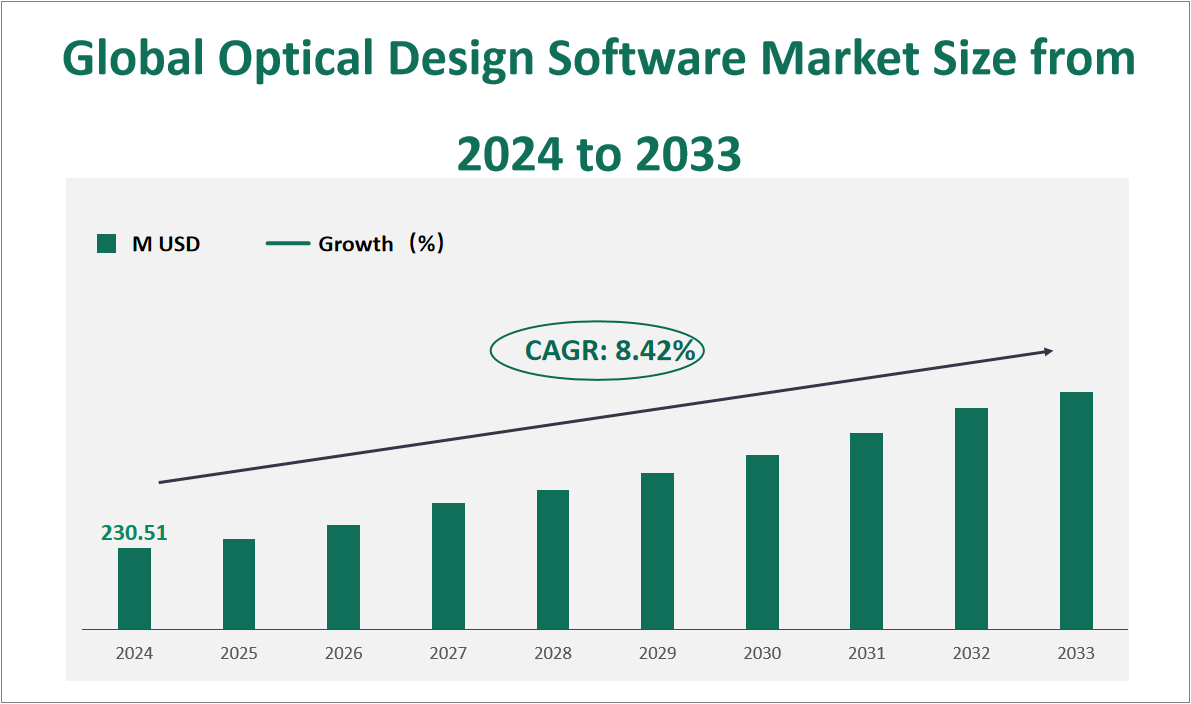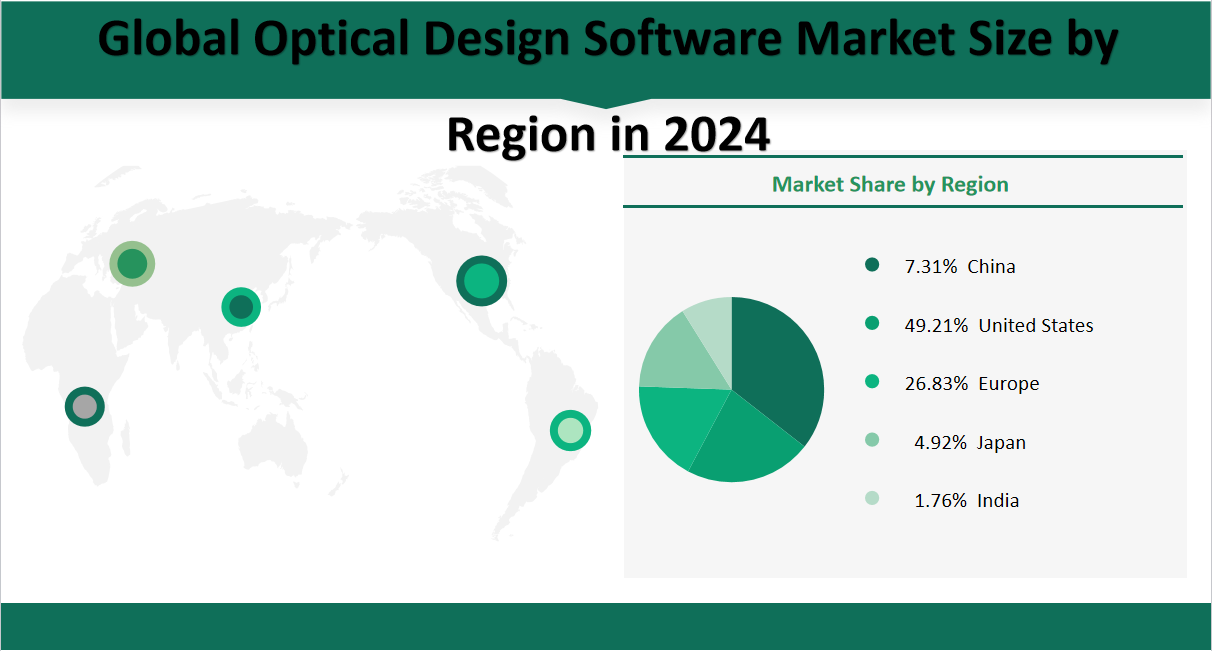1 Global Optical Design Software Market Outlook
The global Optical Design Software market is projected to exhibit substantial growth in the coming years, with a CAGR of 8.42% from 2024 to 2033, reaching a total market size of $230.51 million USD in 2024. Optical Design Software refers to a set of tools that enable optical designers to evaluate and test the performance of optical systems or apparatuses. These tools are instrumental in starting with a design concept and optimizing it to ensure desired performance outcomes. The software includes visualization tools and activities for creating optical systems, which are crucial in various applications such as camera lenses, telescopes, and fiber optics.
Figure Global Optical Design Software Market Size and Growth Rate (2024-2033)

2 Optical Design Software Market Growth Drivers and Constraints
The growth of the Optical Design Software market is significantly driven by the rise of hybrid and new energy vehicles. In recent years, the increasing demand for fuel-efficient vehicles and strict emission regulations have accelerated the development of the new energy and hybrid vehicle markets. Optical Design Softwares play a crucial role in cooling key components such as the motor, inverter, and battery system in these vehicles, leading to an expected significant growth in market demand. However, the market faces challenges such as general cost increases due to rising labor, energy, logistics, and transportation costs, as well as fluctuating raw material prices, which put greater pressure on the operating costs of the Optical Design Software industry. Additionally, the industry experiences intense competition with many participants, and the expanding downstream demand not only brings good prospects for Optical Design Software products but also leads to a continuous increase in industry participants. This intensifying competition may adversely impact the average profit level of the industry. Furthermore, the high technical barrier for new entrants, including the need for deep technical accumulation, R&D team support, and the ability to meet strict quality and supply requirements from vehicle manufacturers, poses a significant challenge for new companies looking to enter the market.
3 Optical Design Software Market Innovations and M&A Activities
In the Optical Design Software industry, mergers and acquisitions, as well as expansion plans, are shaping the competitive landscape. Notably, Mitsubishi Electric, Mitsubishi Electric Mobility, and AISIN have reached a basic agreement to establish a joint venture company to handle products for next-generation electric vehicles, aiming to develop, produce, and sell traction motors, power converters, and control software optimized for electric and hybrid vehicles. This strategic move is in response to the diversifying needs for vehicle electrification and a step towards contributing to global carbon neutrality. Additionally, Nidec and KPS Capital Partners are reportedly in a bidding battle to acquire Innomotics, Siemens’ business spin-off focusing on motors and large drives, with potential sales worth €3bn. These developments underscore the industry’s dynamic nature and the strategic efforts by key players to consolidate their market positions and expand their reach in the evolving electric vehicle sector.
4 Global Optical Design Software Market Analysis by Type
In 2024, the global Optical Design Software market is anticipated to generate substantial revenue, with On-premises and Cloud Based segments contributing significantly to the overall market value. The On-premises segment is projected to yield a revenue of USD 14.02 million, capturing a market share of 6.08%, while the Cloud Based segment is expected to dominate, generating a substantial revenue of USD 216.50 million and commanding a market share of 93.92%. Collectively, these figures underscore the growing preference for Cloud Based solutions in the Optical Design Software industry, reflecting a clear trend towards cloud-computing and its significant impact on the market’s revenue distribution.
Table Global Optical Design Software Market Size and Share by Type in 2024
Type | Market Size in 2024 (M USD) | Market Share in 2024 (%) |
|---|---|---|
On-premises | 14.02 | 6.08% |
Cloud Based | 216.50 | 93.92% |
5 Global Optical Design Software Market Analysis by Application
In 2024, the global Optical Design Software market revenue for applications is led by the Optical Imaging Systems, which is expected to generate a revenue of $117.54 million, accounting for a market share of approximately 50.99%. The Lighting and Illuminatio is projected to contribute $76.26 million in revenue, securing a market share of about 33.08%. Lasers and Fibers and Others contributed $22.90 million and $13.81 million in revenue, respectively, with market shares of 9.94% and 5.99% Overall, the consumption revenue and market share for optical design software in 2024 underscore the software’s growing importance in the global market, driven by technological advancements and the increasing reliance on sophisticated optical solutions across various sectors.
Table Global Optical Design Software Market Size and Share by Application in 2024
Application | Market Size in 2024 (M USD) | Market Share in 2024 (%) |
|---|---|---|
Optical Imaging Systems | 117.54 | 50.99% |
Lasers and Fibers | 22.90 | 9.94% |
Lighting and Illumination | 76.26 | 33.08% |
Others | 13.81 | 5.99% |
6 Global Optical Design Software Market Analysis by Region
In 2024, the global Optical Design Software market revenue by region demonstrated a significant distribution. United States was estimated to generate a revenue of $113.44 million, holding a market share of 49.21%. Europe followed with a revenue of $61.85 million, capturing a 26.83% market share. The China contributed $16.87 million in revenue, securing a 7.31% market share. Japan and the India contributed $11.33 million and $4.06 million in revenue, respectively, with market shares of 4.92% and 1.76%. These figures underscore the varying contributions of each region to the overall Optical Design Software market revenue in 2024.
Figure Global Optical Design Software Market Share by Region in 2024

7 Top 3 Companies of Global Optical Design Software Market
7.1 ANSYS
Company Introduction and Business Overview:
ANSYS is a provider of engineering simulation software and services. The company develops and markets open and flexible solutions to provide a common platform for product development from design concept to final stage testing and validation.
Products Offered:
ANSYS offers a suite of optical design software products that are pivotal in predicting the illumination and optical performance of systems, which is crucial for saving on prototyping time and costs while enhancing product efficiency. Their flagship product, Ansys Speos, provides an intuitive and comprehensive user interface that boosts productivity through the utilization of GPUs for simulation previews and offers easy access to the Ansys multiphysics ecosystem. This software is adept at simulating sensor vision, conducting advanced optical analysis, optimizing optical design, and studying human vision, making it a versatile tool for optical designers.
7.2 Synopsys
Company Introduction and Business Overview:
Synopsys, Inc. is the Silicon to Software™ partner for innovative companies developing the electronic products and software applications people rely on every day. As an S&P 500 company, Synopsys has a long history of being a global leader in electronic design automation (EDA) and semiconductor IP and offers the industry’s broadest portfolio of application security testing tools and services.
Products Offered:
Synopsys, a frontrunner in optical design innovation for over 40 years, offers CODE V, a leading optical system design software that empowers engineers to efficiently create superior optical solutions. CODE V is equipped with a robust design optimization framework, including Global Synthesis, which expedites time to market. It boasts precise and rapid tolerancing capabilities, providing exceptional fabrication support. The software’s groundbreaking beam propagation analysis ensures accurate simulations, pushing the boundaries of optical design. Synopsys’ dedication to excellence is exemplified by CODE V, which is supported by a team of seasoned optical engineers and a wealth of resources such as videos, documentation, tutorials, and example models to assist users throughout their design journey.
CODE V is the tool of choice for a wide array of applications, from photographic and cinema zoom lenses to free-space photonic devices. It has been instrumental in the design of renowned systems like the Hubble Space Telescope’s first servicing optics, machine vision optics, spectrometers, scanners, and diffractive optics systems. Synopsys’ CODE V continues to set the standard in optical design software, offering intuitive and intelligent tools that enable users to tackle optical design tasks of any complexity with ease.
7.3 Excelitas Technologies
Company Introduction and Business Overview:
Excelitas Technologies® Corp. is a leading industrial technology manufacturer focused on delivering innovative, market-driven photonic solutions to meet the illumination, optical, optronic, sensing, detection and imaging needs of OEM and end-user customers. Serving a vast array of applications across biomedical, scientific, semiconductor, industrial manufacturing, safety, security, consumer products, defense and aerospace sectors, Excelitas stands committed to enabling customers’ success in their many various end-markets.
Products Offered:
Excelitas Technologies offers LINOS® WinLens Software, a powerful and intuitive tool designed to streamline the optical design process. This software is specifically tailored to utilize the extensive range of LINOS optical elements and components, making it an invaluable asset for designing optical imaging systems. By providing a comprehensive simulation program, WinLens enables users to efficiently create and optimize their optical systems, enhancing productivity and precision in the field of optical design.

